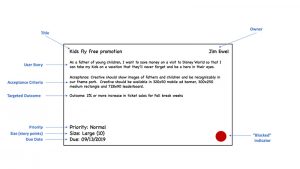 Today, over 80% of organizations have adopted agile development practices in some parts of their software organizations. Among startups, the percentage applying agile may be even higher.
Today, over 80% of organizations have adopted agile development practices in some parts of their software organizations. Among startups, the percentage applying agile may be even higher.
So what percentage of organizations apply agile methods to marketing?
Who knows? There’s no data. But the total lack of data suggests that only a very small percentage of marketers apply agile methods.
The question is “Why?” This makes no sense.
If you’re applying agile methods to release new features of your software every few weeks (or perhaps every few days or hours if you’re Amazon or SalesForce.com), do you really want marketing that operates on six-month cycles?
I didn’t think so.
OK, so perhaps you agree that marketing needs to operate on shorter cycles and move more quickly. But it doesn’t necessarily follow that the methods of agile development (sprints, scrum user stories, burndown charts, etc.) can be successfully applied to marketing.
Good point, but I disagree. I have found that all of these agile methods, with some minor adaptation, can be applied to marketing, and with excellent results.
Scrum
OK, this is a no brainer. Daily 15 minute standup meetings encourage communication, impose discipline, uncover potential problems before they spin out of control and improve morale among self-managing teams. The very act of appointing someone (the Scrum Master) who is not the boss, but who is responsible for tracking progress and removing obstacles that are preventing the team from moving forward, can have a huge positive impact on the productivity of the marketing team. Every marketing team can benefit from Marketing scrums and the appointment of a scrum master.
Sprints
Sprints are simply a way to break down a large project into smaller chunks so that a team can deliver more immediate results and get feedback earlier. Can’t marketing benefit from the same approach? If a marketing program doesn’t work, don’t we want to know after 3-4 weeks, rather than after six months? Don’t we want marketing teams that are implementing programs quickly, measuring the results, and then iterating on what works and what doesn’t?
Sprint planning sessions are also invaluable for marketing, because they force alignment of the marketing team with management and sales, who should attend all sprint planning meetings. Sprint planning also aligns expectations with the resources available, making it much clearer what can be done by when.
Sprint reviews not only serve as a checkpoint to review the commitments made at the sprint planning session, but they also convey to management, sales and the rest of the team marketing’s accomplishments.
User Stories
Marketing can document user stories in two different ways: first, to document the need for new functionality, and second, to document the roles and the stages of the buying process. Good marketing doesn’t sell, it helps users buy. By writing user stories that describe the different personas in the buying process, and the activities that must occur for a successful sale, as well as the acceptance criteria for material that will help the buyer, the marketing department provides themselves with a “specification” for their marketing.
Burndown Charts
OK, I’ll admit that I’ve never used a burndown chart for marketing. But if you think about it, any marketing department that implements user stories, as described above, could use burndown charts to track their implementation.
So how about it, marketers? If you agree, how can we move forward in making agile methods more prevalent in marketing? If you disagree, why? I’d really like to know.




My instinctive, snarky comment is that you’re advocating Agile Marketing because that’s the name of your company (or at least your blog).
But in all seriousness, I agree with you. Having “grown up” in the technology industry, it’s easy to see how development tools and process have moved in this direction (eventually overcoming long-entrenched ‘waterfall’ process advocates).
And so it is with marketing — better tools, media, and especially turnaround time mean those companies who want to surpass competitors will cut their cycle times through incorporating agile/lean ideas.
Paul, thanks for the comment. My business is consulting (as is yours), and I use agile in the consulting, but I use a lot of other things also. I started the blog because I felt like there was an idea here, and it needed more fleshing out and promotion.
BTW, are you part of the Agile Marketing Group on Facebook run by John Cass? If not, happy to put you in touch with him.
You and I need to find a time to get together sometime at an event or over coffee. There are a number of us here in Seattle who like the Agile Marketing approach.
Jim
My instinctive, snarky comment is that you’re advocating Agile Marketing because that’s the name of your company (or at least your blog).
But in all seriousness, I agree with you. Having “grown up” in the technology industry, it’s easy to see how development tools and process have moved in this direction (eventually overcoming long-entrenched ‘waterfall’ process advocates).
And so it is with marketing — better tools, media, and especially turnaround time mean those companies who want to surpass competitors will cut their cycle times through incorporating agile/lean ideas.
Paul, thanks for the comment. My business is consulting (as is yours), and I use agile in the consulting, but I use a lot of other things also. I started the blog because I felt like there was an idea here, and it needed more fleshing out and promotion.
BTW, are you part of the Agile Marketing Group on Facebook run by John Cass? If not, happy to put you in touch with him.
You and I need to find a time to get together sometime at an event or over coffee. There are a number of us here in Seattle who like the Agile Marketing approach.
Jim
I am 100% behind what you are preaching. This is what we practice. Scrums, sprints and user stories help break the work down into manageable chunks and ensures that everyone is pulling in the same direction. The missing piece is, of course, a tool for the Agile Marketer. That is what we have invented.: https://whatsnexx.com/2012/02/customer-state-marketing-the-agile-marketer%E2%80%99s-automation-tool/
I am 100% behind what you are preaching. This is what we practice. Scrums, sprints and user stories help break the work down into manageable chunks and ensures that everyone is pulling in the same direction. The missing piece is, of course, a tool for the Agile Marketer. That is what we have invented.: https://whatsnexx.com/2012/02/customer-state-marketing-the-agile-marketer%E2%80%99s-automation-tool/
Nice article Jim,
We are still in the early adopter stage. Though important marketing leaders are using agile marketing. Salesforce.com, HubSpot and MindJet.
I think it makes sense that technology companies will be the place where agile marketing first gains a foothold. If only to keep up with the agile development team! (you make that point well).
I’d like to ask you, what are the barriers to agile marketing adoption?
John
John, great question. I think there are a couple of barriers. One, I think it’s hard to adopt agile methods if other parts of the organization aren’t supportive – management and sales in particular. Two, I think different areas of marketing lend themselves more easily to agile than others, and it may make sense to get started in one of these areas: digital marketing, email campaigns, case studies, collateral, microsites, social media campaigns, lead generation, event support and channel training. Other areas of marketing do not lend themselves as well to agile: positioning, pricing, market definition, competitive analysis.
I’d also add that most agile tools are oriented more towards developers than marketers. Some of them can be used by marketing groups, but there’s probably an opportunity here for software developers.
Jim
Great answer… I wonder if we should discuss one aspect of marketing in detail that lends itself to agile, and one that doesn’t? Email marketing and positioning respectively.
Nice article Jim,
We are still in the early adopter stage. Though important marketing leaders are using agile marketing. Salesforce.com, HubSpot and MindJet.
I think it makes sense that technology companies will be the place where agile marketing first gains a foothold. If only to keep up with the agile development team! (you make that point well).
I’d like to ask you, what are the barriers to agile marketing adoption?
John
John, great question. I think there are a couple of barriers. One, I think it’s hard to adopt agile methods if other parts of the organization aren’t supportive – management and sales in particular. Two, I think different areas of marketing lend themselves more easily to agile than others, and it may make sense to get started in one of these areas: digital marketing, email campaigns, case studies, collateral, microsites, social media campaigns, lead generation, event support and channel training. Other areas of marketing do not lend themselves as well to agile: positioning, pricing, market definition, competitive analysis.
I’d also add that most agile tools are oriented more towards developers than marketers. Some of them can be used by marketing groups, but there’s probably an opportunity here for software developers.
Jim
Great answer… I wonder if we should discuss one aspect of marketing in detail that lends itself to agile, and one that doesn’t? Email marketing and positioning respectively.
Pingback: Agile Marketing Series: What is Agile Marketing? | Conspire: A Mindjet Publication
Pingback: Agile Marketing Series: What is Agile Marketing? | Conspire: A Mindjet Publication
I am definitely into Agile Marketing. Thanks for the content and elaboration. Just wanted to add that considering the heavy usage of online marketing tools and platforms such as Google Adwords, in which you can make instant changes and receive instant results, incorporating scrum into marketing can be very justified. The iterative approach and being data dependent is a vital in marketing these days. Thanks again…
Pingback: Agile Digital Marketing: What is it and how to implement it? | idowed75
Pingback: Agile Digital Marketing: What is it and how to implement it? | Blog
Pingback: 3 Tactics for Agile Marketing Plus Resources to Get Started | Glew
Pingback: 3 Tactics for Agile Marketing Plus Resources to Get Started | Torus Sphere